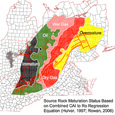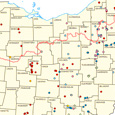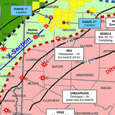Who owns the mineral rights? The Ohio Supreme Court may decide
Thursday, June 5, 2014

CALDWELL, Ohio — A fight over who owns the mineral rights under 42 acres of land in Noble County may be headed to the Ohio Supreme Court.
Jon Walker Jr. filed a lawsuit against John R. Noon in 2012 in an attempt to get the mineral rights to the property. Walker owns the surface rights.
Background
According to court records, Noon purchased the property in 1964 and severed the mineral rights from the surface rights when he sold the property in 1965. In 1970, the property changed hands two more times.
Then, in 2009, Walker purchased the property. In December 2011, Walker sent a notice of abandonment of mineral interest to Noon.
But in January 2012, Noon filed an affidavit and laid claim to preserve his mineral interest.
In April 2012, Walked filed a complaint for judgment. He requested the trial court rule that he is the lawful owner of the mineral rights.
Walker claimed in the court records that the mineral rights merged with the surface rights in 1992 by the way of the 1989 Ohio Dormant
Mineral Act
He claimed Noon abandoned his interest in the mineral rights when he failed to stop them from expiring.
Meanwhile, Noon filed a mineral preservation notice with the court in the spring of 2012.
The Noble County Court found that Walker did own the rights and denied Noon’s motion to keep his mineral rights.
Court of Appeals
Noon then filed an appeal with the Seventh District Court of Appeals in April 2013. Noon died after filing the appeal. His daughter, Patricia Shondrick-Nau, was substituted in the case since she is the executor of Noon’s estate.
The issues in the case revolve around the 1989 version of the Ohio Dormant Minerals Act and the 2006 version of the same law. This is the first case to go to court over how the acts intersect and what it means to the surface owner and the mineral rights owner.
The Seventh District Court of Appeals ruled April 3 that Walker does own the mineral rights since Noon reportedly didn’t develop them since 1964.
Ohio Dormant Minerals Act
The Ohio’s Dormant Minerals Act, which is part of the Ohio state law, provides a surface owner with the opportunity to gain title to previously severed mineral rights if those rights have not been “used” during a specific 20-year time period.
The 2006 version of the Ohio Dormant Minerals Act specifically applies to any mineral interest, defined as a “fee interest in at least one mineral regardless of how the interest is created and of the form of the interest, which may be absolute or fractional or divided or undivided.”
The 1989 version of the statute did not define the interests subject to abandonment.
The 1989 version of the Dormant Minerals Act has been described as a “use it or lose it” statute: if the mineral-interest owners did not “use” their mineral interests during a 20-year time period, they automatically vested in the surface owner.
The 2006 version of the Dormant Minerals Act says the surface owner must adhere to a multi-step process to accomplish the merging of the surface and mineral interests. The surface owner must confirm that the oil and gas mineral interests have not been used within the previous 20 years.
Then the surface owner must “serve notice by certified mail, return receipt requested, to each holder or each holder’s successors or assignees, at the last known address of each, of the owner’s intent to declare the mineral interest abandoned.”
If certified mail notice is not possible, the surface owner must publish notice at least once in a newspaper of general circulation in each county in which the land is located.
The surface owner must also confirm that one of the mineral interest holders has not recorded documents within 60 days of service or publication of the notice laying claim to the mineral rights.
Then the surface rights owner must file an affidavit of abandonment in the county recorder’s office between 30 and 60 days after the published notice date.
Ohio Supreme Court
Patricia Shondrick-Nau has appealed the Seventh District Court of Appeals decision to the Ohio Supreme Court, according to her attorney, Matthew Warnock, of Bricker & Eckler, Columbus.
Warnock said it is unknown if the Ohio Supreme Court will hear the case.
Walker’s attorney has 30 days from May 16 to file a memorandum in response to the filing. If Walker files a response, the Ohio Supreme
Court will then take two to four months to decide if it will consider the appeal.
However, Chesapeake Exploration has filed a friend of the court brief, asking for the Supreme Court to look into the case because it will impact so many landowners.
In addition, the federal court in Columbus has asked the Ohio Supreme Court to examine the issues in the case because justices are waiting to make a decision in a separate, unrelated federal case, based on the Ohio court’s decision.
The case is gaining interest because the decision could impact so many landowners since the Seventh District Court of Appeals covers Belmont, Carroll, Columbiana, Harrison, Jefferson, Mahoning, Monroe and Noble counties, which are all involved in shale exploration.
Decision stands
If the Ohio Supreme Court declines to hear the case, then the mineral rights will be remanded to Walker as was ruled in the Seventh District Court of Appeals.




